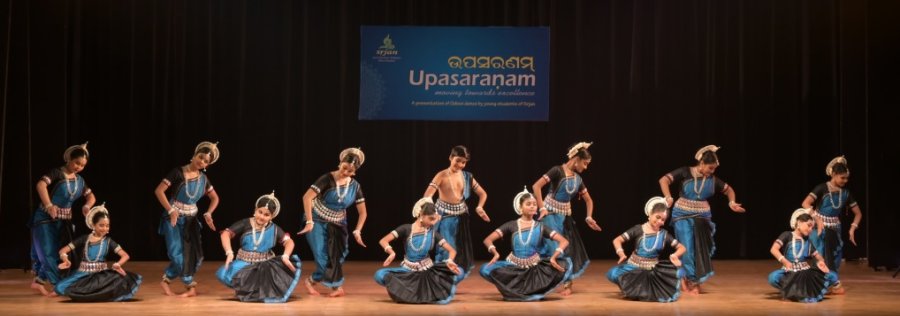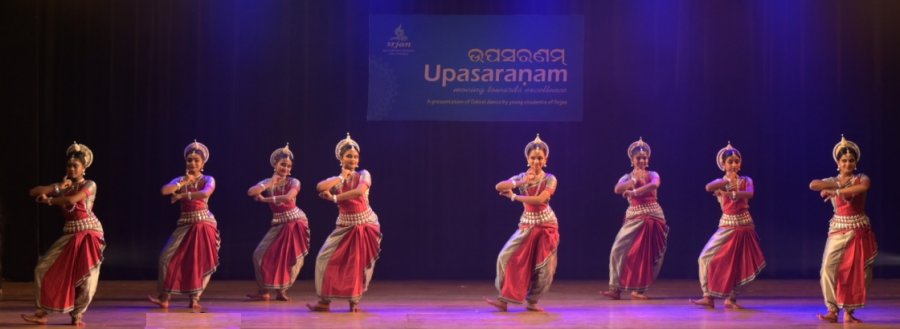
|   |

|   |
Srjan celebrates 'Upasaranam-Moving towards Excellence' in its 30th year - Maya Krishnamurty e-mail: maya.krishnamurty@gmail.com Photos: Ganesh Sahoo July 3, 2023 In the 30th year of its establishment, Srjan-Guru Kelucharan Mohaptra Odissi Nrityabasa, Bhubaneswar, organized the fourth edition of Upasaranam-Moving towards Excellence, a celebration of the young students and learners at Srjan, who presented an evening of Odissi dance. The stage of Rabindra Mandap, Bhubaneswar came alive with their dreams, hopes, and talent on June 10. With 57 young performers taking the stage, the evening was conducted by Dr. Mrutyunjaya Rath, with the able light designing and programme execution of Debiprasad Mishra. The programme commenced with a welcome address by Guru Ratikant Mohapatra, Director, Srjan. This was followed by the ceremonial lighting of the lamp and speeches by the guests of honour. In their messaging, they were of one mind-recognizing the importance of nurturing and fostering the young minds and dancers of today, who will become the flagbearers of our rich culture and heritage tomorrow.  Mangalacharan The dance presentations began with a Mangalacharan, a traditional invocation of an Odissi dance repertoire that marks the entrance of the dancer onto the stage. After seeking the blessings of Lord Jagannath for an auspicious beginning and offering salutations to Mother Earth (Bhumi Pranam), the young dancers presented a Shloka Vandana in obeisance to Lord Vishnu. Natasha Das, Anushka Goswami, Sai Arohi Das, Swagatika Acharya, Anushree Rath, Tanistha Pradhan, Sreyansi Survijyoti, Susamparna Mohanty, and Anuska Gadhei performed the Vishnu Vandana, Shantakaram Bhujagashayanam, bowing down to the master of the universe, the supreme being who destroys within us the fear of samsara. Set to Dr. Bijay Kumar Jena's music composition in raga Gurjari Todi, and ektali and triputa tala, Guru Ratikant Mohapatra's choreography was renewed in a group dance form by senior Srjan ensemble member Aishwariya Singhdev.  Guru Vandana This was followed by Guru Vandana, a composition of Guru Ratikant Mohapatra, set to the music of Sampagodu S. Vighnaraja in Ragamalika (composed in ragas Bhairav, Bairagi, Darbari, and Bhairavi) and adi tala. In this auspicious shloka, Gurur Brahmaa, Gurur Vishnuh, Gurur Devo Maheshwarah, Guruh Saakshaat Parambrahma Tasmai Shree Gurave Namah, the dancers invoked the blessings of the Almighty and the Guru to sustain their eternal quest for knowledge and dispel their ignorance. The choreographic original was renewed in the group format for the evening by Srjan ensemble member G. Sanjay. Guru Vandana was performed by the youngest batch of learners at Srjan, dancers Saanvi Mohapatra, Ravya Das, Tejaswini Rout, Anwesha Lenka, Aisha Shetty, Bisakha Bishnupriya Sahoo, Shivangi Praharaj, Sulagna Behera, Angel Mishra, Ayushi Ray, Hritikankshya Sahoo, Brahmi Sanhita Jnanagamya, Trisha Praharaj, Adyashree Acharya, Swetalina Acharya, Akshita Nandini, Sheryangshree Mahapatra, Akanksha Mahapatra, and Jigyansha Jayashree Chhualsingh.  Batu Nritya The third presentation, the technically demanding nritta piece Batu (in honour of Lord Batuka Bhairava, one of the 64 aspects of Lord Shiva) was performed by slightly older children to the renewed presentation of Preetisha Mohapatra, senior Srjan ensemble member. The original composition is a choreograph of Guru Kelucharan Mohapatra set to Pandit Bhubaneswar Mishra's music in raga Kalyan and ektali. As the sthayi remained constant throughout the duration of the dance composition, the dancers, Chinmayee Das, Archisha Sahu, Shanvi Mishra, Deepanwita Tripathy, Pratyasa Das, Trishna Krishani, Subhalaxmi Mahapatra, Gayatri Pradhan, Pritishree Sahu, Satakshi Mohanty, Deepika Mohanty, Roshni Behera, and Sai Prasad Panda performed Batu with its sculpturesque poses, musical depictions, and rhythm patterns in varying stage formations.  Arabhi Pallavi Batu was followed by the presentation of Arabhi Pallavi, another nritta piece, in raga Arabhi and ektali, a beautiful music composition of Pt Bhubaneswar Mishra choreographed by Guru Kelucharan Mohapatra originally in 1972. The beauty of the Pallavi is that it gradually unfolds from graceful, sinuous movements into a harmonious elaboration of dance, music, and rhythm. The renewed group composition of Arabhi Pallavi by Sujata Pradhan, Srjan faculty, was performed by Pratyasha Nayak, Shagun Praharaj, Amrita Nanda, Asmita Kamila Sahoo, Gul Mohapatra, Seeyashree Samantaray, Navya Saishree Chhualsingh, and Shreya Saroj Mallik.  Samakala The performance finale was by the senior-most student group of Srjan, trained by seasoned Odissi dancer and teacher Rajashri Praharaj. They performed Samakala, a neo-classical Odissi dance piece choreographed by Guru Ratikant Mohapatra in adi tala, composed by violinist Agnimitra Behera and flautist Srinibas Satapathy. Dressed in shades of green, the dancers Prachi Mohanty, Sruti Jyoshna Das, Nishita Panda, Abhisikta Senapati, Dipranwita Dalei, Angelina Pal, Amrita Suhani, and Priti Prangya Paikaray concluded the evening with good confidence and energy. The young artistes were aided in their presentations by recorded musical accompaniment-on mardala by Guru Kelucharan Mohapatra and Guru Ratikant Mohapatra; on vocals by Guru Ghanashyam Panda, Dr. Bijaya Kumar Jena, and Satyabrata Katha; on violin by Ramesh Chandra Das and Agnimitra Behera; on flute by Nityananda Mahapatra, Abhiram Nanda, and Srinibas Satpathy; on sitar by Rabishankar Pradhan; and on synthesizer by Saroj Kumar Rath, Subrat Rautray, and Bibhuprasad Tripathy. From the conception of the idea of Srjan in 1992 at a workshop at the celebrated National Centre for Performing Arts (NCPA), Mumbai, where Guru Kelucharan Mohapatra was conducting a workshop with his senior disciples, to its establishment in September 1993 and subsequent evolution into a professional Odissi institution, Srjan's journey in Art has been ever-expanding. Today, under the direction of Guru Ratikant Mohapatra, both the performing and teaching wings take pride of place in this journey and Upasaranam is but one small step in this odyssey through Odissi.  Maya Krishnamurty is a trained Odissi dancer, and freelance verbal trainer and language editor based in Bangalore. Maya holds a post-graduate diploma in Journalism and Mass Communication from Xavier Institute of Communications, Mumbai and has been learning Odissi for over a decade. |